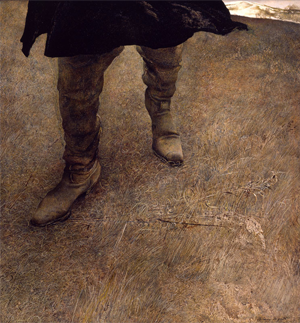Introduction
The art piece Trodden Weed is a painting depicting a man’s boots walking on a patch bearing what appear to be weeds. It was created in 1951 by the artist Andrew Wyeth, who later came out to explain that it was self-portrait.
According to Wyeth, he had undergone an eight-hour surgical operation on his lung and during the recuperation period, he spent some time walking trying to regain his strength (Wyeth 1).
It was during one of these recovery walks that he took some time to rest and as he was looking down at his feet, it occurred to him that he had been crushing things under his feet (Wyeth 1).
Having gone through an operation, during which his heart was said to have stopped once, Wyeth had come to appreciate the importance of life. That is why he found it disheartening that he had been killing without knowing and he proceeded to put this message on a painting (Wyeth 1).
Writing about a work of art is regarded as one of the best aids to fully understanding it. This essay seeks to analyze the painting titled Trodden Weed by Andrew Wyeth, using the four steps of art criticism.

Description
The painting was created using the medium Tempera on Wood. Tempera is a painting mixture that is created by combining colored pigment with a binding medium (traditionally egg yolk). Tempera once applied on a material dries fast and becomes permanent.
Wyeth is counted among the few 20th century American artists, who specialized in Tempera art. When painting using Tempera, a small amount of pigment paste is placed on a palette then some drops of distilled water are added.
The binder (egg yolk) is then added to mixture depending on the desired consistency. Wyeth probably chose this media because of its longevity.
Analysis
The painting was done from a second-person (observational) point of view. It was as if Wyeth was looking at another person’s feet when painting. In terms of balance, the boots and the weeds, the primary subjects of the painting, have been given prominence with each taking almost half of the entire painting.
The boots give weight to the top left side of the painting, while the weeds cover every other section apart from a small bit on the top right where a portion of the sky is showing.
In order to create a three-dimensional feel to the painting, the artist, played around with the element of perspective. The sky is shown peeping at a distance, with the path that Wyeth had charted in his walk presenting in a tapering line that widens towards the foreground.
By discriminately shading some parts and leaving others out, Wyeth was able to distinguish the texture of various components. He also used different types of strokes to make some elements appear smooth and others rough.
For instance, in the grass on the foreground, Wyeth used long and rough strokes, while on the trousers he made the strokes short and fine. The lighting of the painting, which appears to have been well thought-out, indicates that the walk was happening in the afternoon.
The shade and tone of the painting is earthy with the color selection yielding a painting that does not scream for attention.
The mood of the painting is that of solace and loneliness. From the first look, one can tell that the subject is walking alone. The background, which stretches all the way to the horizon, does not have other people clearly indicating that the subject has not come across anyone in his long walk.
Interpretation
From a personal point of view, the theme of the work is the difference between the strong and weak. In any society, stronger people tend to take advantage of the weaker ones, sometimes at will, for their own benefit.
For instance, politicians in most countries enter parliament and change the laws to favor them at the expense of other members of the public. The walking legs clearly show the will of a strong living person to get from one point to another.
The dead weeds show how the weak lose out when a stronger people opt to exercise their dominance on them. The long distance that the subject has been walking, causing damage, depicts the extent of destruction that one strong person can cause when placed against hundreds of weak individuals.
Evaluation/Conclusion
Had I not take time to critically study the painting I would have dismissed it as another pair of walking legs. However, after a committed study that was in part guided by external references, I have come to the conclusion that there is more to the painting than meets the eye.
I now understand deeply understand the style that was used in creating the artwork, as well as the circumstances that led to its creation. I am also in a position to give an informed interpretation based on the analytical process. This analytical process can be applied in different pieces of art to derive meaning.
Works Cited
Wyeth, Andrew. Trodden Weed 1951. Web.